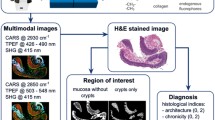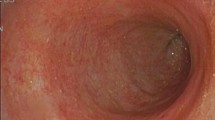Abstract
Background and aims
No endoscopic examination has been able to evaluate severity of ulcerative colitis (UC) by quantification. This prospective study investigated the efficacy of quantifying autofluorescence imaging (AFI) to assess the severity of UC, which captures the fluorescence emitted from intestinal tissue and then quantifies the intensity using an image-analytical software program.
Materials and methods
Eleven endoscopists separately evaluated 135 images of conventional endoscopy (CE) and AFI from a same lesion. A CE image corresponding to Mayo endoscopic subscore 0 or 1 was defined as being inactive. The fluorescence intensities of AFI were quantified using an image-analytical software program (F index; FI). Active inflammation was defined when Matts’ histological grade was 2 or more. A cut-off value of the FI for active inflammation was determined using a receiver operating characteristic (ROC) analysis. The inter-observer consistency was calculated by unweighted kappa statistics.
Results
The correlation coefficient for the FI was inversely related to the histological severity (r = −0.558, p < 0.0001). The ROC analysis showed that the optimal cut-off value for the FI for active inflammation was 0.906. The average diagnostic accuracy of the FI was significantly higher than those of the CE (84.7 vs 78.5 %, p < 0.01). The kappa values for the inter-observer consistency of CE and the FI were 0.60 and 0.95 in all participants, 0.53 and 0.97 in the less-experienced endoscopists group and 0.67 and 0.93 in the expert group, respectively.
Conclusions
The quantified AFI is considered to be an accurate and objective indicator that can be used to assess the activity of ulcerative colitis, particularly for less-experienced endoscopists.



Similar content being viewed by others
References
Rogler G (2012) Inflammatory bowel disease cancer risk, detection and surveillance. Dig Dis 30(suppl 2):48–54
Truelove SC, Richards WC (1956) Biopsy studies in ulcerative colitis. Br Med J 1:1315–8
Matts SG (1961) The value of rectal biopsy in the diagnosis of ulcerative colitis. Q J Med 30:393–407
Dick AP, Holt LP, Dalton ER (1966) Persistence of mucosal abnormality in ulcerative colitis. Gut 7:355–60
D’Haens G, Sandborn WJ, Feagan BG et al (2007) A review of activity indices and efficacy end points for clinical trials of medical therapy in adults with ulcerative colitis. Gastroenterology 132:763–86
Riley SA (1991) Microscopic activity in ulcerative colitis: what does it mean? Gut 32:174–8
Dick AP (1966) Persistence of mucosal abnormality in ulcerative colitis. Gut 7:355–60
Florén CH (1987) Histologic and colonoscopic assessment of disease extension in ulcerative colitis. Scand J Gastroenterol 22:459–62
Gomes P (1986) Relationship between disease activity indices and colonoscopic findings in patients with colonic inflammatory bowel disease. Gut 27:92–5
Lemmens B (2013) Correlation between the endoscopic and histologic score in assessing the activity of ulcerative colitis. Inflamm Bowel Dis 19:1194–201
Thia KT, Loftus EV Jr, Pardi DS et al (2011) Measurement of disease activity in ulcerative colitis: interobserver agreement and predictors of severity. Inflamm Bowel Dis 17:1257–64
Osada T, Ohkusa T, Yokoyama T et al (2010) Comparison of several activity indices for the evaluation of endoscopic activity in UC: inter- and intraobserver consistency. Inflamm Bowel Dis 16:192–7
Sato R, Fujiya M, Watari J et al (2011) The diagnostic accuracy of high-resolution endoscopy, autofluorescence imaging and narrow-band imaging for differentially diagnosing colon adenoma. Endoscopy 43:862–8
Moriichi K, Fujiya M, Sato R et al (2012) Autofluorescence imaging and the quantitative intensity of fluorescence for evaluating the dysplastic grade of colonic neoplasms. Int J Colorectal Dis 27:325–30
Ueno N, Fujiya M, Moriichi K et al (2011) Endosopic autofluorescence imaging is useful for the differential diagnosis of intestinal lymphomas resembling lymphoid hyperplasia. J Clin Gastroenterol 45:507–13
Fujiya M, Saitoh Y, Watari J et al (2007) Auto-fluorescence imaging is useful to assess the activity of ulcerative colitis. Dig Endosc 19:145–9
Osada T, Arakawa A, Sakamoto N et al (2011) Autofluorescence imaging endoscopy for identification and assessment of inflammatory ulcerative colitis. World J Gastroenterol 17:5110–6
Takehana S, Kaneko M, Mizuno H (1999) Endoscopic diagnostic system using autofluorescence. Diagnostic and Therapeutic Endoscopy 5:59–63
Nakashima A, Miwa H, Watanabe H et al (2001) A new technique: light-induced fluorescence endoscopy in combination with pharmacoendoscopy. Gastrointest Endosc 53:343–8
Fujiya M, Saitoh Y, Watari J et al (2007) Auto-fluorescence imaging is useful to assess the activity of ulcerative colitis. Dig Endosc 19:145–9
Ueno N, Fujiya M, Moriichi K et al (2011) Endosopic autofluorescence imaging is useful for the differential diagnosis of intestinal lymphomas resembling lymphoid hyperplasia. J Clin Gastroenterol 45:507–13
Kanda Y (2013) Investigation of the freely-available easy-to-use software “EZR” (Easy R) for medical statistics. Bone Marrow Transplant 48:452–458
Riley SA, Mani V, Goodman MJ et al (1991) Microscopic activity in ulcerative colitis: what does it mean? Gut 32:174–8
Dick AP, Holt LP, Dalton ER (1966) Persistence of mucosal abnormality in ulcerative colitis. Gut 7:355–60
Florén CH, Benoni C, Willén R (1987) Histologic and colonoscopic assessment of disease extension in ulcerative colitis. Scand J Gastroenterol 22:459–62
Lemmens B, Arijs I, Van Assche G et al (2013) Correlation between the endoscopic and histologic score in assessing the activity of ulcerative colitis. Inflamm Bowel Dis 19:1194–201
D’Haens G, Sandborn WJ, Feagan BG et al (2007) A review of activity indices and efficacy end points for clinical trials of medical therapy in adults with ulcerative colitis. Gastroenterology 132:763–86
Conflict of interest
The authors declare that they have no competing interests.
Author contributions
MK and MF provided major input into the conceptual development of the studies, wrote the manuscript, and supervised all investigations. KM, MI, KT, AS, TD, SF, KA, YN, and NU performed the endoscopic examinations. YI assessed the histological findings. SK, TG, JS, and TI managed and treated the enrolled patients and collected and analyzed the data. HT, YS, and YK helped design studies, interpret the data, and prepare/review the manuscript.
Author information
Authors and Affiliations
Corresponding author
Additional information
Kentaro Moriichi and Mikihiro Fujiya contributed equally to this work.
Rights and permissions
About this article
Cite this article
Moriichi, K., Fujiya, M., Ijiri, M. et al. Quantification of autofluorescence imaging can accurately and objectively assess the severity of ulcerative colitis. Int J Colorectal Dis 30, 1639–1643 (2015). https://doi.org/10.1007/s00384-015-2332-5
Accepted:
Published:
Issue Date:
DOI: https://doi.org/10.1007/s00384-015-2332-5




